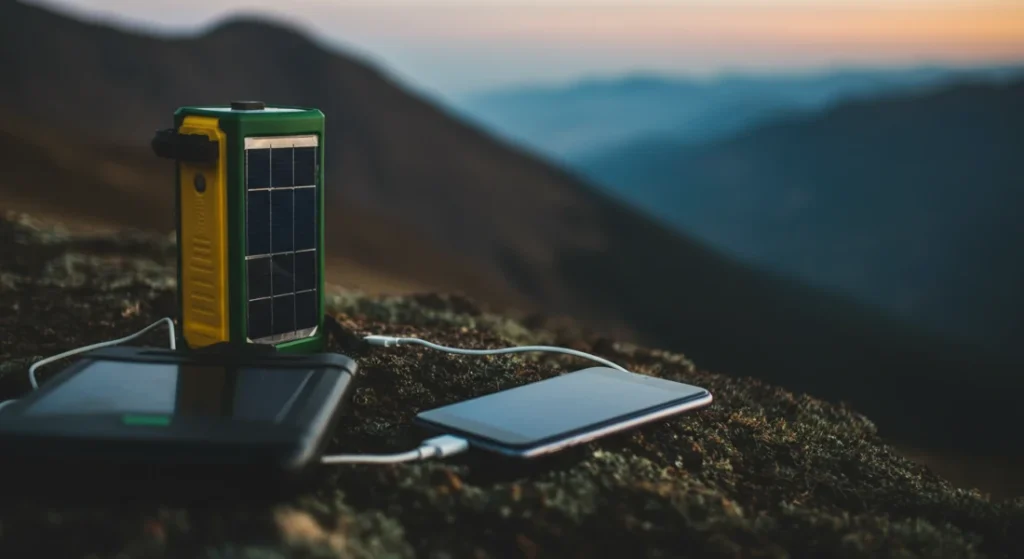In times of war, civil unrest, or prolonged power outages, staying connected can be a matter of survival. Your phone, radio, or flashlight may be your only link to the outside world—providing access to news, emergency services, and communication with loved ones. But when the electricity goes out for days or even weeks, how do you keep these essential devices charged?
This guide will show you practical and effective ways to keep your devices powered, even when there’s no electricity. Whether you are sheltering in place or forced to evacuate, these methods will help you stay prepared.

Step 1: Prioritize the Devices That Matter Most
When power is limited, you need to focus on the most critical devices. These should be:
- Your phone – For emergency calls, news updates, and navigation.
- A flashlight or headlamp – Essential for safety at night.
- A radio – A battery-powered or hand-crank radio keeps you updated on the situation.
- A power bank – To extend your phone’s battery life.
- Rechargeable batteries – If you have devices that require AA/AAA batteries, rechargeable ones are a great option.
What NOT to Do:
- Avoid wasting power on entertainment (videos, gaming, or social media scrolling).
- Do not leave devices charging overnight when power sources are scarce.
- Do not rely on one single charging method—always have backup options.
Step 2: Use Portable Power Banks
A power bank is one of the easiest ways to keep your devices running without electricity.
How to Choose a Power Bank for Emergencies:
- High capacity – Look for at least 10,000mAh to 30,000mAh for multiple charges.
- Multiple USB ports – So you can charge more than one device at a time.
- Fast charging support – To charge your phone quickly when power is available.
- Solar charging feature (optional) – Some power banks have built-in solar panels.
How to Use Power Banks Wisely:
- Charge your power bank whenever electricity is available.
- Keep your phone in battery-saving mode to extend power.
- Only charge essential devices.
What NOT to do:
- Don’t buy cheap, unreliable power banks—they can fail when you need them most.
- Avoid using power-hungry apps while charging your phone.
- Don’t store power banks in hot or freezing conditions—this reduces lifespan.
Step 3: Harness Solar Power
Solar chargers are one of the best long-term solutions for keeping devices charged when electricity is unavailable.
Best Solar Charging Options:
- Portable solar panels – Lightweight and foldable, ideal for charging phones and power banks.
- Solar power banks – A good backup, though they charge slowly via sunlight.
- Larger solar kits – These can charge laptops and multiple devices but are bulkier.
How to Use Solar Chargers Effectively:
- Place panels in direct sunlight for maximum efficiency.
- Charge a power bank first, then use it to charge devices.
- Angle panels correctly throughout the day to get the most power.
What NOT to do:
- Do not expect solar chargers to work well on cloudy days—efficiency drops significantly.
- Avoid buying low-quality solar panels that charge too slowly to be practical.
- Don’t leave solar panels in unsafe locations where they can be stolen.
Step 4: Use Hand-Crank Chargers
Hand-crank chargers work by manually turning a handle to generate power. While they are not the most efficient, they are a lifesaver when all other options fail.
Pros and Cons of Hand-Crank Chargers:
✔ Works anytime, day or night.
✔ No reliance on sun or stored power.
✘ Requires a lot of effort.
✘ Charges devices very slowly (best for emergency calls or texts).
Best Ways to Use a Hand-Crank Charger:
- Use only for short emergency phone calls or texts.
- Combine with a small power bank to store the generated power.
- Consider getting a hand-crank radio with a built-in USB charger.
What NOT to do:
- Don’t expect to fully charge a phone with a hand-crank alone—it’s for emergency use only.
- Avoid low-quality models that break easily.
Step 5: Car Charging as a Backup
If you have access to a vehicle, your car’s battery can serve as an excellent backup power source.
How to Charge Devices Using Your Car:
- Use a car USB charger – Many modern cars have built-in USB ports.
- Get a power inverter – This allows you to charge laptops and other devices using the car’s battery.
- Run the engine periodically – This keeps the battery from draining completely.
Precautions When Using a Car Battery:
- Charge devices only when necessary to avoid draining the car’s battery.
- Do not leave the car running in a closed space—this can cause carbon monoxide poisoning.
- Be mindful of fuel availability—in a prolonged crisis, gas stations may be empty.
What NOT to do:
- Don’t drain your car battery completely—you may need the vehicle for evacuation.
- Avoid using high-wattage appliances (like heaters or kettles) that can kill the battery quickly.
Step 6: Reduce Battery Consumption on Your Devices
No matter how many charging options you have, making your phone’s battery last longer is critical.
How to Extend Your Phone’s Battery Life:
- Enable battery-saving mode – Most smartphones have a built-in power-saving option.
- Turn off unnecessary features – Wi-Fi, Bluetooth, GPS, and background apps drain power.
- Lower screen brightness – A simple way to reduce battery consumption.
- Put your phone in airplane mode when not using it.
- Use text messaging instead of calls – SMS uses less power than voice calls.
What NOT to do:
- Don’t keep refreshing social media or news apps—they drain your battery.
- Avoid keeping your screen on for long periods.
- Do not rely on fast-charging all the time—it wears out battery life faster.
Be Smart, Be Prepared
Power outages during war, civil unrest, or natural disasters can last for days or weeks. Being prepared with multiple charging options ensures you stay connected, informed, and safe.
By following this guide, you will:
- Have backup power sources like power banks and solar panels.
- Use energy wisely to make your devices last longer.
- Know alternative charging methods in case of prolonged blackouts.
Preparation starts now. Invest in reliable power solutions, test your equipment, and always have a backup plan. Your ability to stay connected may one day save your life.




